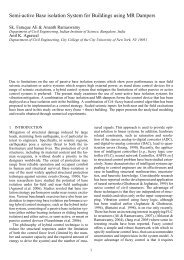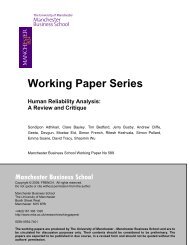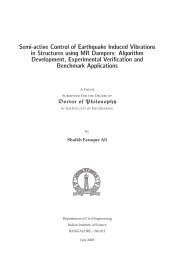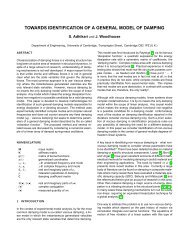K - Swansea University
K - Swansea University
K - Swansea University
Create successful ePaper yourself
Turn your PDF publications into a flip-book with our unique Google optimized e-Paper software.
Atomistic Mechanics ofNanoscale Structures: Static& Dynamic AnalysesSondipon AdhikariIISc Bangalore13 January 2012
Where is <strong>Swansea</strong>?London – UK CapitalLess than three hoursby car or train(192 miles)Wales<strong>Swansea</strong>Cardiff - Welsh CapitalLess than an hour awayby car or train
Title ofpresentationClick to edit subtitle style
OverviewØ IntroductionØ Atomistic finite element methodØ Carbon nanotubes: static and dynamic analysis, bucklingØ Fullerenes: vibration spectraØ Graphene: static and dynamic analysis, compositesØ Nanobio sensors: vibrating nanotube and graphene basedmass sensorØ DNA mechanicsØ Conclusions
Research Areasu Atomistic finite element methodu Nonlocal continuum mechanics for nanoscale objectsu Nanoscale bio sensorsu Uncertainty quantification in modelling and simulationu Dynamic analysis of complex structuresu Vibration energy harvesting
Collaboratorsu Prof F Scarpa (<strong>University</strong> of Bristol)u Dr R Chowdhury, Dr C Wang, Dr A Gil, Prof P Rees(<strong>Swansea</strong> <strong>University</strong>).u Dr T Murmu, Prof M McCarthy (<strong>University</strong> of Limerick)Acknowledgements
Carbon NanotubesTitle ofpresentationClick to edit subtitle style
Can we use continuum mechanics at thenanoslace?u What about the“holes”?u Can we have an“equivalent” continuummodel with “correct”properties?u How defects can betaken into account ?
Which Young's modulus?Effective Longitudinal SurfaceY =11πRF2ε11Y =11F2πRdε11Y s =11F2πRε11
Which Young's modulus?
Yakobson’s paradox(Wang CY, Zhang LC, 2008. Nanotechnology 19, 075705)(Huang Y, Wu J, Hwang K C, 2006. Phys. Rev. B 74, 245413)
Atomistic finite element methodu Atomic bonds are represented by beam elementsu Beam properties are obtained by energy balanceU r= 1 2 k rU total=U r+U θ+U τ( Δr) 2 U θ= 1 2 k θ ( Δθ) 2 U τ= 1 2 k τΔφU axial= 1 2 K axial (ΔL)2 = EA2L (ΔL)2U torsion= 1 2 K torsion (Δβ)2 = GJ( ) 2U bending= 1 2 K bending (2α)2 = EI2L2L (Δβ)4 + Φ1+ Φ (2α)2Scarpa, F. and Adhikari, S., "A mechanical equivalence for the Poisson's ratio and thickness of C-C bonds in single wallcarbon nanotubes", Journal of Physics D: Applied Physics, 41 (2008) 085306
Atomistic finite element methodu All parameters of the beam can be obtained in closed-form:E = 4k rLπd 2 ,G = 32k τLπd 4( )32k τL 2 ( 7+12ν + 4ν 2)d < 2 6Φ = 3k rd 4 6 +12ν + 6ν 2k θ= k r d 2164Α + ΒΑ + ΒΑ =112L 2 k τ+192L 2 k τν + 64L 2 k τν 2k τk rΒ = 9k rd 4 +18k rd 4 ν + 9k rd 4 ν 2Scarpa, F. and Adhikari, S., "A mechanical equivalence for the Poisson's ratio and thickness of C-C bonds in single wallcarbon nanotubes", Journal of Physics D: Applied Physics, 41 (2008) 085306
Atomistic Structural MechanicsFor space frames:[ K] { u} = { f} [K] à stiffness matrix{u} à nodal displacement vector{f} à nodal force vector(Weaver Jr., W. and Gere, J.M., 1990. Matrix Analysis ofFramed Structures. (third ed.),, Van Nostrand Reinhold, NewYork)
Atomistic FE – bending deformation ofSWCNTs(F Scarpa and S Adhikari, 2008. J. Phys. D: App. Phys., 41, 085306)
Atomistic FE – bending deformation ofSWCNTs bundlesSimilarity between hexagonalSWCNT packing bundle andstructural idealization for wing boxesPolar moment of inertia for each CNT:I cπ ⎡⎡⎛⎛= ⎢⎢⎜⎜R +4 ⎢⎢⎣⎣⎝⎝4d ⎞⎞⎟⎟2 ⎠⎠⎛⎛ d− ⎜⎜ R −⎝⎝ 24⎞⎞⎟⎟⎠⎠⎤⎤⎥⎥⎥⎥⎦⎦(1)Polar moment of inertia for hexagonal packing:2⎛⎛2l ⎞⎞Ihex4⎜⎜⎛⎛ ⎞⎞0= Ic+ ⎜⎜3⎟⎟ A ⎟⎟c+ 3I⎜⎜ ⎜⎜ 2 ⎟⎟ ⎟⎟⎝⎝ ⎝⎝ ⎠⎠ ⎠⎠Y = YfIIhexhc(2)Flexural modulus of the nanbundle:(3)Yf⎡⎡3322= 20 3πRd 7 3πRd64 3πRt( ) ( ) ( ) ( ) ⎥⎥ ⎥⎥ ⎤⎤VdWd 16 3πRtVdWdY ⎢⎢+++444⎢⎢⎣⎣3 2R+ t 33 2 + 11 2 + 11 2 +4VdWR tVdWR tVdWR tVdW⎦⎦(F Scarpa and S Adhikari, 2008. J. Phys. D: App. Phys., 41, 085306)
Atomistic FE – bending deformation ofSWCNTs bundles(F Scarpa and S Adhikari, 2008. J. Phys. D: App. Phys., 41, 085306)
Buckling of Carbon nanotubes(a) Molecular dynamics(b) Hyperplastic atomistic FE (Ogdenstrain energy density function )Comparison of bucklingmechanisms in a (5,5) SWCNTwith 5.0 nm length.Flores, E. I. S., Adhikari, S., Friswell, M. I. and Scarpa, F., "Hyperelastic axialbuckling of single wall carbon nanotubes", Physica E: Low-dimensionalSystems and Nanostructures, 44[2] (2011), pp. 525-529.
Carbon nanotubes with defectsu We are interested in the changes in the mechanicalproperties!Scarpa, F., Adhikari, S. and Wang, C. Y., "Mechanical properties of nonreconstructed defective single wall carbon nanotubes", Journal of Physics D:Applied Physics, 42 (2009) 142002
Carbon nanotubes with defects(a) Ratio between mean of axial Young’s modulus and pristine stiffness and (b)between standard deviation of the Young’s modulus against pristine Young’smodulus for armchair (n,n). Pristine Young’s modulus Y 0 : 2.9, 1.36, 0.91, 0.67TPa for a thickness d = 0.084 nm. ● = 2 % NRV; ■ = 1.5 % NRV; ▲= 1 % NRV;♦= 0.5 % NRV
FullereneTitle ofpresentationClick to edit subtitle style
Vibration spectra of fullerene familyThe variation of the first natural frequency across thethe complete range of fullerenes. The 8 sphericaltype of fullerenes include C60 , C80 , C180 , C60 ,C240 , C260 , C320 , C500 , C720and the 8 ellipsoidal (or non-spherical) type offullerenes include C20 , C30 , C40 , C50 , C70 , C90 ,C100 and C540 (fullerenes are not drawn in scale).Adhikari, S. and Chowdhury, R., "Vibration spectra of fullerene family", PhysicsLetters A, 375[22] (2011), pp. 1276-1280.
Thin shell theoryThe natural frequencies of spherical fullerenes can be given by
Atomistic Simulation vs Shell theoryFrequency (THz)30C 80C 60b 225 a 25020 a 1 C C 20180CC 26020a15 2 240C15C 32030C10 C 50010C740 C 5090C 4055 C C540 C 70100000.01 0.02 0.03 0.04 0 0.02 0.04 0.06 0.081/M 1/2 (amu 1/2 )1/M 1/2 (amu 1/2 )Frequency (THz)30b 2a 0Ellipsoidal type fullerenesSpherical type fullerenes
GrapheneTitle ofpresentationClick to edit subtitle style
Atomistic FE – in-plane SLGS(F Scarpa, S Adhikari, A S Phani, 2009. Nanotechnology 20, 065709)
Atomistic FE vs Continuum – SLGSCircular SLGS (R = 9: 5 nm)under central loading. Distributionof equivalent membrane stresses.Deformation of rectangular SLGS(15.1 x 13.03 nm 2 ) under centralloading.Scarpa, F., Adhikari, S., Gil, A. J. and Remillat, C., "The bending of single layer graphenesheets: Lattice versus continuum approach", Nanotechnology, 21[12] (2010), pp. 125702:1-9.
Axtomistic FE vs Continuum – SLGSFR 2 /Y/d 33530252015Lattice R = 2.5 nmContinuum R = 2.5 nmLattice R = 5.0 nmContinuum R = 5.0 nmLattice R = 9.5 nmContinuum R = 9.5 nmEq. (17)F a b/Y/d 33530252015Lattice a = 3.88 nmContinuum a = 3.88 nmLattice a = 5.0 nmContinuum a = 5.0 nmLattice a = 15.1 nmContinuum a = 15.1 nmEq. (18)10105500 0.5 1 1.5 2 2.5 3w/d00 0.5 1 1.5 2w/dComparison of the nondimensional force vs. nondimensional out-of-plane displacement forcircular and rectangular lattice and continuum SLGS.
Analytical approach for SLGS –honeycomb structureC-C bonds deform under stretching and hingingK h8k=dτ2Hinging constant related to thickness dApplying averaging of stretching andhinging deformation over unit cell:Eν1214=3d=ν123k( k + 3K)rrK1−Kh=1+3KhhhkrkrEG2124=3d3k( k + 3K)rr3K= 3 dKhh( k + K )rhkrh• Isotropic for “infinite” graphene sheet• Orthotropic for finite size grapheneand considering edge effectsF Scarpa, S Adhikari, A S Phani, 2009. Nanotechnology 20, 065709
Analytical approach for SLGS –honeycomb structureUnit cell made by rods withstanding axial andbending deformationYY4Lk=πdF Scarpa, S Adhikari, A S Phani, 2009. Nanotechnology 20, 065709(L Kollár and I Hegedús. Analysis and design of space frames by the Continuum Method. Developments in Civil Engineering, 10.Elsevier, Amsterdam, 1985)a−fg−n16k=πLdr2sθ2bEquivalent Young’s modulus foraxial membersEquivalent Young’s modulus foraxial membersA Rigidity matrix is obtained using a latticecontinuum modelling of space frames àequivalence with plane stress formulation for aplane sheet:( k L + )1 4 3 2E =r122d 9Lmaxk θν =13
Atomistic FE – Bilayer Graphene• Equivalent to structural “sandwich” beams• C-C bonds in graphene layers represented withclassical equivalent beam models• “Core” represented by Lennard-Jones potentialinteractions:r min = 0.383 nmε = 2.39 meVE f=0.5 TPa (I.W. Frank, D.M. Tanenbaum, A.M. van der Zande,P.L. McEuen, J. Vac. Sci. Technol. B 25 (2007) 2558)Scarpa, F., Adhikari, S. and Chowdhury, R., "The transverse elasticity of bilayergraphene", Physics Letters A, 374[19-20] (2010), pp. 2053-2057.
Mechanical vibration of SLGSLumped mass matrix:Minimisation of the Hamiltonian for the i th mode:Comparison against Molecular Mechanicsmodel based on the eigenvalue analysis ofthe system Hessian matrixScarpa, F., Chowdhury, R., Kam, K., Adhikari, S. and Ruzzene, M., "Wave propagation in graphene nanoribbons", Nanoscale ResearchLetters, 6 (2011), pp. 430:1-10.Chowdhury, R., Adhikari, S., Scarpa, F. and Friswell, M. I., "Transverse vibration of single layer graphene sheets", Journal of Physics D:Applied Physics, 44[20] (2011), pp. 205401:1-11.
Mechanical vibration of SLGS• (8,0) nanoribbons with different lengths• Errors between 2 and 3 %• Average thickness d = 0.077 nm
Graphene compositesPolymer MatrixGraphene sheetvan der Waals interaction250200ArmchairGRP2ZigzagGRP4 1(GHz)1501005000 5 10 15 20Length (nm)Chandra, Y., Chowdhury, R., Scarpa, F., Adhikari, S. and Seinz, J.,"Multiscale modeling on dynamic behaviour of graphene basedcomposites", Materials Science and Engineering B, in press.
Nanobio SensorsTitle ofpresentationClick to edit subtitle style
Vibration based mass sensor: CNTPoint massChowdhury, R., Adhikari, S. and Mitchell, J., "Vibrating carbonnanotube based bio-sensors", Physica E: Low-dimensionalSystems and Nanostructures, 42[2] (2009), pp. 104-109.Distributed massAdhikari, S. and Chowdhury, R., "The calibration of carbonnanotube based bio-nano sensors", Journal of Applied Physics,107[12] (2010), pp. 124322:1-8
Vibration based mass sensor: CNTThe equation of motion of free-vibration:The resonance frequencies:The Mode shapes:We use energy principles to obtain the frequency shift due to theadded mass.
Vibration based mass sensor: CNTNatural frequency with the added mass:Identification of the added mass
Vibration based mass sensor: CNTMass of a nano object can be detected from the frequency shift ΔfAdhikari, S. and Chowdhury, R., "The calibration of carbon nanotube basedbio-nano sensors", Journal of Applied Physics, 107[12] (2010), pp.124322:1-8
Vibration based mass sensor: CNTMass of a nano object can be detected from the frequency shiftΔf0.45CNT with deoxythymidineNormalized added mass: M / A L0.40.350.30.250.20.150.10.05Molecular mechanicsExact solutionCalibration constant based approachAdhikari, S. and Chowdhury, R., "The calibration of carbon nanotube basedbio-nano sensors", Journal of Applied Physics, 107[12] (2010), pp.124322:1-8 00 0.05 0.1 0.15 0.2 0.25 0.3 0.35 0.4Relative frequency shift: f / f n0
Vibration based mass sensor: GrapheneVibrating graphene sheets can be used as sensors with differentmass arrangements
Vibration based mass sensor: GrapheneRelative added mass:
Vibration based mass sensor: GrapheneVibrating graphene sheets can be used as sensors with differentmass arrangementsFixed edge10.9Molecular mechanicsProposed approachSLGS with adenosineNormalized added mass: µ = M / (ab)0.80.70.60.50.40.30.20.100 0.1 0.2 0.3 0.4 0.5 0.6Relative frequency shift: f / f 0
Boron Nitride Nanotube and NanosheetsTitle ofpresentationClick to edit subtitle style
Axial vibration of BNNT(a) (a) Axial vibration and itsassociated frequency of (b)zigzag and (c) armchairBNNTs given by the MMsimulations (discrete dots)and a column model withYoung’s modulus 1TPa(solid lines).Chowdhury, R., Wang, C. W., Adhikari, S. and Scarpa, F., "Vibration and symmetry-breakingof boron nitride nanotubes", Nanotechnology, 21[36] (2010), pp. 365702:1-9. !
Torsional vibration of BNNT(a) (a) Torsional vibration and itsassociated frequency of (b) zigzagand (c) armchair BNNTs given bythe MM simulations (discrete dots)and a column model with shearmodulus 0.41TPa (solid lines).!Chowdhury, R., Wang, C. W., Adhikari, S. and Scarpa, F., "Vibration and symmetry-breakingof boron nitride nanotubes", Nanotechnology, 21[36] (2010), pp. 365702:1-9.
Optimised shape of BNNT(a)(d)(c)(b)Optimized configurationof armchair BNNTs: (a)(3, 3), (b) (4,4) and (c)(6,6) with the aspectratio 15, and (d) short(6, 6) with the aspectratio 2.
Mechanical property of BN SheetsExample of armchair (4, 0) BN sheet.Boron atoms are in red, nitrogenatoms are in green.Boldrin, L., Scarpa, F., Chowdhury, R., Adhikari, S. and Ruzzene, M., "Effective mechanicalproperties of hexagonal boron nitride nanosheets", Nanotechnology, 22[50] (2011), pp.505702:1-7.
DNA MechanicsTitle ofpresentationClick to edit subtitle style
Atomistic FE of DNAFrom protein data bank file to ANSYS input file – a new code forautomatic translation
Atomistic FE of DNAMaterial properties of the beams are obtained depending on thenature of the bondsMode 3 (MM:33.679; FE 38.768 GHz) Mode 6 (MM:111.696; FE 112.71 GHz)
ConclusionsØ Atomistic finite element method is developed for generalnanosalce structures:§ Carbon nanotube§ Fullerenes§ Graphene§ Nanoscale bio sensorsØ Programs have been written to convert pdb files to Finite Elementgeometry file and material propertiesØ Encouraging results compared to MM simulation were obtainedØ Future: nonlinearity, large-scale problems such as proteins &nanocomposites, molecular dynamic simulations, experimentalvalidation
References1. Murmu, T. and Adhikari, S., "Nonlocal frequency analysis of nanoscale biosensors", Sensors & Actuators: A.Physical, 173[1] (2012), pp. 41-48.2. Boldrin, L., Scarpa, F., Chowdhury, R., Adhikari, S. and Ruzzene, M., "Effective mechanical properties ofhexagonal boron nitride nanosheets", Nanotechnology, 22[50] (2011), pp. 505702:1-7.3. Murmu, T., Seinz, J., Adhikari, S. and Arnold, C., "Nonlocal buckling behaviour of bonded double-nanoplatesystem",Journal of Applied Physics, 110[8] (2011), pp. 084316:1-8.4. Flores, E. I. S., Adhikari, S., Friswell, M. I. and Scarpa, F., "Hyperelastic axial buckling of single wall carbonnanotubes", Physica E: Low-dimensional Systems and Nanostructures, 44[2] (2011), pp. 525-529.5. Murmu, T. and Adhikari, S., "Nonlocal vibration of bonded double-nanoplate-systems", Composites Part B:Engineering, 42[7] (2011), pp. 1901-1911.6. Chandra, Y., Chowdhury, R., Adhikari, S. and Scarpa, F., "Elastic instability of bilayer graphene using atomisticfinite element", Physica E: Low-dimensional Systems and Nanostructures, 44[1] (2011), pp. 12-16. 7. Scarpa, F., Chowdhury, R., Kam, K., Adhikari, S. and Ruzzene, M., "Wave propagation in graphenenanoribbons", Nanoscale Research Letters, 6 (2011), pp. 430:1-10. 8. Chowdhury, R. and Adhikari, S., "Boron nitride nanotubes as zeptogram-scale bio-nano sensors: Theoreticalinvestigations", IEEE Transactions on Nanotechnology, 10[4] (2011), pp. 659-667. 9. Chandra, Y., Chowdhury, R., Scarpa, F. and Adhikari, S., "Vibrational characteristics of bilayer graphenesheets", Thin Solid Films, 519[18] (2011), pp. 6026-6032. 10. Adhikari, S. and Chowdhury, R., "Vibration spectra of fullerene family", Physics Letters A, 375[22] (2011), pp.1276-1280.
References11. Murmu, T., Adhikari, S. and Wang, C. W., "Torsional vibration of carbon nanotube-buckyball systems based onnonlocal elasticity theory", Physica E: Low-dimensional Systems and Nanostructures, 43[6] (2011), pp.1276-1280. 12. Wang, C. W. and Adhikari, S., "ZnO-CNT composite nanowires as nanoresonators", Physics Letters A, 375[22](2011), pp. 2171-2175. 13. Chowdhury, R., Adhikari, S., Scarpa, F. and Friswell, M. I., "Transverse vibration of single layer graphenesheets", Journal of Physics D: Applied Physics, 44[20] (2011), pp. 205401:1-11. 14. Scarpa, F., Chowdhury, R., and Adhikari, S., "Thickness and in-plane elasticity of Graphane", Physics LettersA, 375[20] (2011), pp. 2071-2074. 15. Wang, C. W., Murmu, T. and Adhikari, S., "Mechanisms of nonlocal effect on the vibration of nanoplates",Applied Physics Letters, 98[15] (2011), pp. 153101:1-3. 16. Murmu, T. and Adhikari, S., "Nonlocal vibration of carbon nanotubes with attached buckyballs at tip",Mechanics Research Communications, 38[1] (2011), pp. 62-67. 17. Chowdhury, R., Adhikari, S. and Scarpa, F., "Vibrational analysis of ZnO nanotubes: A molecular mechanicsapproach", Applied Physics A, 102[2] (2011), pp. 301-308. 18. Chowdhury, R., Adhikari, S., Rees, P., Scarpa, F., and Wilks, S.P., "Graphene based bio-sensor usingtransport properties", Physical Review B, 83[4] (2011), pp. 045401:1-8. 19. Murmu, T. and Adhikari, S., "Axial instability of double-nanobeam-systems", Physics Letters A, 375[3] (2011),pp. 601-608. 20. Flores, E. I. S., Adhikari, S., Friswell, M. I. and F. Scarpa, "Hyperelastic finite element model for single wallcarbon nanotubes in tension", Computational Materials Science, 50[3] (2011), pp. 1083-1087.
References21. Murmu, T. and Adhikari, S., "Scale-dependent vibration analysis of prestressed carbon nanotubes undergoingrotation", Journal of Applied Physics, 108[12] (2010), pp. 123507:1-7. 22. Scarpa, F., Adhikari, S. and Phani, A. Srikanth, "Auxeticity in single layer graphene sheets", InternationalJournal of Novel Materials, 1[2] (2010), pp. 39-43. 23. Murmu, T. and Adhikari, S., "Nonlocal effects in the longitudinal vibration of double-nanorod systems", PhysicaE: Low-dimensional Systems and Nanostructures, 43[1] (2010), pp. 415-422. 24. Murmu, T. and Adhikari, S., "Nonlocal transverse vibration of double-nanobeam-systems", Journal AppliedPhysics, 108[8] (2010), pp. 083514:1-9. 25. Scarpa, F., Peng, H. X., Boldri, L., Remillat, C. D. L., Adhikari, S., "Coupled thermo-mechanics of single-wallcarbon nanotubes", Applied Physics Letters, 97[15] (2010), pp. 151903:1-3. 26. Chowdhury, R., Adhikari, S., Rees, P., "Optical properties of silicon doped ZnO", Physica B: CondensedMatter, 405[23] (2010), pp. 4763-4767. 27. Chowdhury, R., Wang, C. W., Adhikari, S. and Scarpa, F., "Vibration and symmetry-breaking of boron nitridenanotubes", Nanotechnology, 21[36] (2010), pp. 365702:1-9. 28. Wang, C. Y., Zhao, Y., Adhikari, S. and Feng, Y. T., "Vibration of axially strained triple-wall carbon nanotubes",Journal of Computational and Theoretical Nanoscience, 7[11] (2010), pp. 2176-2185. 29. Adhikari, S. and Chowdhury, R., "The calibration of carbon nanotube based bio-nano sensors", Journal ofApplied Physics, 107[12] (2010), pp. 124322:1-8. 30. Chowdhury, R., Wang, C. Y., Adhikari, S., and Tong, F. M., "Sliding oscillations of multiwall carbon nanotubes",Physica E: Low-dimensional Systems and Nanostructures, 42[9] (2010), pp. 2295-2300.
References31. Chowdhury, R., Adhikari, S., Wang, C. W. and Scarpa, F., "A molecular mechanics approach for the vibrationof single walled carbon nanotubes", Computational Materials Science, 48[4] (2010), pp. 730-735. 32. Wang, C. Y., Li, C. F., and Adhikari, S., "Axisymmetric vibration of singlewall carbon nanotubes in water",Physics Letters A, 374[24] (2010), pp. 2467-2474. 33. Chowdhury, R., Adhikari, S. and Scarpa, F., "Elasticity and piezoelectricity of zinc oxide nanostructure",Physica E: Low-dimensional Systems and Nanostructures, 42[8] (2010), pp. 2036-2040. 34. Gil, A. J., Adhikari, S., Scarpa, F., and Bonet, J., "The formation of wrinkles in single layer graphene sheetsunder nanoindentation", Journal of Physics: Condensed Matter, 22[14] (2010), pp. 145302:1-6. 35. Scarpa, F., Adhikari, S. and Chowdhury, R., "The transverse elasticity of bilayer graphene", Physics Letters A,374[19-20] (2010), pp. 2053-2057. 36. Scarpa, F., Adhikari, S., Gil, A. J. and Remillat, C., "The bending of single layer graphene sheets: Latticeversus continuum approach", Nanotechnology, 21[12] (2010), pp. 125702:1-9. 37. Chowdhury, R., Rees, P., Adhikari, S., Scarpa, F., and Wilks, S.P., "Electronic structures of silicon doped ZnO",Physica B: Condensed Matter, 405[8] (2010), pp. 1980-1985. 38. Scarpa, F., Adhikari, S. and Wang, C. Y., "Nanocomposites with auxetic nanotubes", International Journal ofSmart and Nanomaterials, 1[2] (2010), pp. 83-94. 39. Chowdhury, R., Wang, C. Y. and Adhikari, S., "Low-frequency vibration of multiwall carbon nanotubes withheterogeneous boundaries", Journal of Physics D: Applied Physics, 43[11] (2010), pp. 085405:1-8. 40. Chowdhury, R., Adhikari, S. and Mitchell, J., "Vibrating carbon nanotube based bio-sensors", Physica E: LowdimensionalSystems and Nanostructures, 42[2] (2009), pp. 104-109.
References41. Scarpa, F., Adhikari, S. and Wang, C. Y., "Mechanical properties of non reconstructed defective single wallcarbon nanotubes", Journal of Physics D: Applied Physics, 42 (2009) 142002 (6pp). 42. Wang, C. Y., Li, C. F., and Adhikari, S., "Dynamic behaviors of microtubules in cytosol", Journal ofBiomechanics, 42[9] (2009), pp. 1270-1274. 43. Tong, F. M., Wang, C. Y., and Adhikari, S., "Axial buckling of multiwall carbon nanotubes with heterogeneousboundary conditions", Journal of Applied Physics, 105 (2009), pp. 094325:1-7. 44. Scarpa, F., Adhikari, S. and Phani, A. Srikanth, "Effective mechanical properties of single graphene sheets",Nanotechnology, 20[1-2] (2009), pp. 065709:1-11. 45. Scarpa, F. and Adhikari, S., "Uncertainty modelling of carbon nanotube terahertz oscillators", Journal of Non-Crystalline Solids, 354[35-39] (2008), pp. 4151-4156. 46. Scarpa, F. and Adhikari, S., "A mechanical equivalence for the Poisson's ratio and thickness of C-C bonds insingle wall carbon nanotubes", Journal of Physics D: Applied Physics, 41 (2008) 085306 (5pp).






